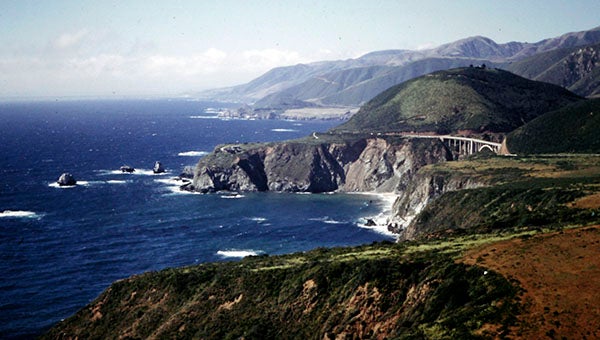On California Highway 1
Published 1:19 pm Saturday, June 6, 2015

The Pacific Ocean and cliffs along the sea just off Route 1 along the Californian Coast. — SUBMITTED | Archie Howell
by James Howell
We’ve done a couple of short trips in the trailer and decide to take a week’s vacation up the fabled Pacific Coast Highway to Oregon. It’s midsummer; the boys are out of school and we pack for a change in atmosphere and territory. Our experiences have hardened us to short-term vagabond life.
We decide to roughly divide the trip into two segments: one to San Francisco and the second along the coast to Tillamook, Oregon. From there, we’ll cross over to the inland route and larger highways for the return. Faster will be better coming home; we can adjust plans along the way.
We make a conscious decision to not stop at the Hearst Castle at San Simeone. To do so would cost us at least two days and we want to see the coast. It does not disappoint; we take time to walk beaches, visit sea lion caves and smell the clear air of the Pacific Ocean.
The California coast is a visual delight. We move from low promontories to almost in the surf, separated by only a low beach sand buffer. Low to moderate hills separate us from the wide San Joaquin valley to the east. There are few roads through the barrancas; state parks share territory with long-time settler’s houses and ranches.
Rock outcroppings and large rock strewn surf areas under a clear blue sky are the norm. We use the pull off spaces to take breaks, get out and feel the air. The rest of the world seems a long distance away. It is, in fact, a long distance away by road.
Several lighthouses dot the coastline, warning seafarers of rocky hazards. Morning fog is frequent and dense. The Japanese current, circumnavigating the North Pacific Ocean, moderates the temperature of both water and air all along this coast. The same current that produces screaming winds and rough seas in Adak cools and cleans the air here.
After a very long day we pull into the Big Sur Campgrounds. The stay will be short, but we still take some time for a brief hike along well marked trails into the hills. The air is still and hot on the hillside; our trailer is safe, cool and comfortable in the valley campground.
We pack up and head north toward San Francisco. It promises to be a little less tiring and stressful than yesterday. We set our sights on Muir Woods for overnight camping.
This stretch of coast is similar to yesterday’s, only more rocks and overlooks. The hills rise sharper to the east and few access roads enter that wilderness. The Carmel Highlands anchor the south side of a wonderful, craggy, rocky point of land before entering Carmel Valley. This is the beginning of the Monterrey Peninsula, and the setting of John Steinbeck’s books.
Civilization becomes a part of our sightseeing here; small towns and villages dot the highway all the way to the Golden Gate Bridge. Our interest in San Francisco is only in passing. Street traffic is more challenging with the trailer and buildings are just a blur in the distance. Nuances of architecture and street life are completely missed.
We drive across the wonderful bridge, conscious that we have only seen pictures before. The water far below is a little choppy; it’s probably the tidal movement. The bridge is partially shrouded in typical morning fog. Vehicular traffic is light; it’s well past morning rush hour. We pull into the Golden Gate Park on the north east ramparts to the bridge.
We take a break for food and exercise; the park is made for rest and show. There’s a wide esplanade around the top of the hill, with excellent views of the Golden Gate Bridge, San Francisco Bay and city, and the Horseshoe Bay. Open to public view and interaction are large chunks of redwood tree trunks, with visitors graffiti registering a wide variety of travelers. Our kids and dog have a fun time climbing over, under and through the display. Fog still obscures the topmost sections of the bridge, but it is still impressive, and it’s good to walk around and smell the air.
From San Francisco, for about 300 miles, all the way to Oregon’s border is a succession of state and national forests. Muir Woods, named for the famous naturalist John Muir, begins the fir tree wonderland. It’s a National Monument today, a gift from people that felt strongly that its natural beauty should be preserved.
Our route diverges from the main road again, we visit Muir Beach, and continue along the coastal road north. We find a campground late in the day, set up in a redwood grove, and spend a quiet night among the giants.
Tomorrow, Oregon.
JAMES D. “ARCHIE” HOWELL is a Southampton County native and 1955 graduate of Franklin High School. He can be reached at archiepix@kingwoodcable.com.





